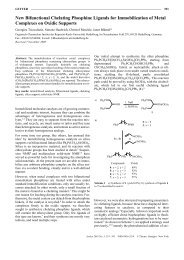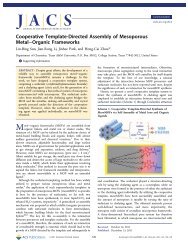Singlet Fission - Department of Chemistry
Singlet Fission - Department of Chemistry
Singlet Fission - Department of Chemistry
You also want an ePaper? Increase the reach of your titles
YUMPU automatically turns print PDFs into web optimized ePapers that Google loves.
AN Chemical Reviews, XXXX, Vol. xxx, No. xx Smith and Michl<br />
a refusion <strong>of</strong> the correlated triplet pair, with a calculated<br />
fusion probability <strong>of</strong> 70%. The lower limit <strong>of</strong> the diffusion<br />
coefficient was calculated to be 10 -4 cm 2 s -1 with a<br />
corresponding one-dimensional fusion rate constant <strong>of</strong> 5 cm<br />
s -1 . No evidence <strong>of</strong> self-trapping was observed for 22a and<br />
22b. For films <strong>of</strong> 22c, 125 the three-dimensional fusion rate<br />
constant was estimated to be 5 units<br />
apart to be considered separated.<br />
5.2. Poly(diethyl dipropargylmalonate)<br />
Poly(diethyl dipropargylmalonate) (23) can be prepared<br />
with conjugation lengths that typically exceed 100 double<br />
bonds and is therefore used to approximate an infinite chain<br />
polymer. When THF solutions <strong>of</strong> 23 were excited in the<br />
range <strong>of</strong> 1.8-2.5 eV, overlapping the peak absorption,<br />
transient signals decayed to zero after 5 ps. 228 When excited<br />
at 3.2 eV with a 200 fs pulse, an additional long-lived excited<br />
state absorption at 1.85 eV appeared within the excitation<br />
time. This excited state absorption has been assigned to<br />
triplets created by fission <strong>of</strong> the 2 1 Ag - state.<br />
5.3. Poly(p-phenylene)<br />
Poly(p-phenylenes) are electroluminescent polymers that<br />
can be used in solar cells, as photoconductors and laser<br />
materials. 229 The triplet yield action spectrum <strong>of</strong> methylsubstituted<br />
ladder-type poly(p-phenylene) (24) films has been<br />
measured using a photomodulation technique. 114,115,230 A step<br />
due to intersystem crossing can be seen near the S1 energy<br />
<strong>of</strong> 2.6 eV. At higher energies, a rise in the triplet photogeneration<br />
takes place with an onset <strong>of</strong> 3.2 eV and continues<br />
for several tenths <strong>of</strong> an eV before reaching a plateau at 3.7<br />
eV. This triplet photogeneration is attributed to fission <strong>of</strong><br />
hot excitons. The triplet energy E(T1) ) 1.6 eV. The gradual<br />
rise in the triplet photogeneration action spectrum has been<br />
modeled, taking into consideration two factors: inhomogeneous<br />
broadening due to variations in conjugation length and<br />
the release <strong>of</strong> vibrational energy. 112<br />
5.4. Poly(p-phenylene vinylene)<br />
These polymers have been <strong>of</strong> interest in organic solar<br />
cells. 231 The triplet yield action spectrum <strong>of</strong> poly(p-phenylene<br />
vinylene) (25) thin films has been measured 112,116,117 by the<br />
same photomodulation technique as described above for<br />
24, 112,114,115 with qualitatively similar results. For poly(pphenylene<br />
vinylene), the onset <strong>of</strong> triplets produced by singlet<br />
fission in the action spectrum occurs at 3.1 eV, with a gradual<br />
increase to a plateau at 4.4 eV. The corresponding triplet<br />
energy E(T1) is 1.55 eV, whereas the energy <strong>of</strong> the singlet<br />
E(S1) is 2.45 eV. The authors attribute the gradual rise in<br />
triplet yield with excitation energy to the same causes as<br />
described above for 24, namely, inhomogeneous broadening<br />
and generation <strong>of</strong> strongly coupled vibrations. The intensity<br />
dependence <strong>of</strong> the triplet yield is linear at low pump<br />
intensities, becoming proportional to I 1/2 at higher pump<br />
intensities. 117 The latter is indicative <strong>of</strong> bimolecular decay<br />
<strong>of</strong> the triplets. The spatial extent <strong>of</strong> the triplet exciton wave<br />
function is 3.2 Å, based on photoinduced absorption detected<br />
magnetic resonance measurements. 116<br />
5.5. Polythiophene<br />
Regiorandom (RRa-) and regioregular (RR-) poly(3hexylthiophene)<br />
(26) are <strong>of</strong> interest for use in organic solar<br />
cells and optoelectronics. 232,233 RR-26 forms 2D lamellar<br />
structures with strong interactions between polymer chains<br />
and with delocalized singlet excitons. In contrast, RRa-26<br />
films are amorphous and singlet excitons are localized.<br />
Exciton formation has been studied in both RRa-26 and RR-<br />
26 using transient absorption spectroscopy. 234 In RRa-26,<br />
2E(T1) was slightly above the excitation energy used and<br />
triplet excitons were formed on the ps time scale by fission<br />
<strong>of</strong> a highly excited singlet produced by singlet-singlet<br />
fusion. In RR-26, 2E(T1) was approximately equal to the<br />
excitation energy used. No triplet formation was observed<br />
in this case, presumably because the interchain interactions<br />
in RR-26 favor the formation <strong>of</strong> polaron pairs over the singlet<br />
fission process.<br />
6. Dimers<br />
Covalently linked dimers are interesting systems for the<br />
study <strong>of</strong> singlet fission as they contain the minimum number<br />
<strong>of</strong> chromophores necessary for the process to occur. They<br />
<strong>of</strong>fer an opportunity to study singlet fission on isolated<br />
molecules in solution and to examine the effect <strong>of</strong> various<br />
modes <strong>of</strong> interchromophore coupling. At the same time, they<br />
do not permit the two triplet excitations to diffuse apart, and<br />
they allow a study <strong>of</strong> their interaction as a function <strong>of</strong> time.<br />
<strong>Singlet</strong> fission in covalently linked dimers has been<br />
demonstrated for two types <strong>of</strong> parent monomeric chromophores,<br />
2 and 8. Both monomers undergo efficient singlet<br />
fission in their crystalline form, albeit in the former case only<br />
at temperatures above ∼165 K 82 (see section 3.1.2). However,<br />
it is not immediately obvious that singlet fission will<br />
be efficient in the covalent dimers as well.



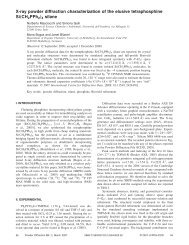

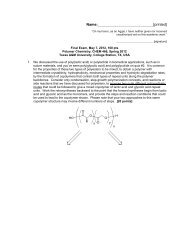

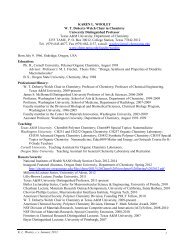
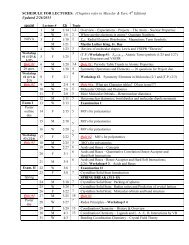
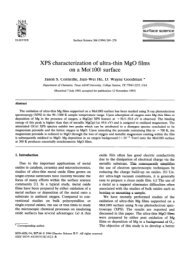
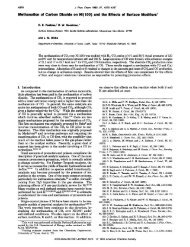
![Radical salts of TTF derivatives with the metal–metal bonded [Re2Cl8]](https://img.yumpu.com/10115211/1/190x253/radical-salts-of-ttf-derivatives-with-the-metal-metal-bonded-re2cl8.jpg?quality=85)



